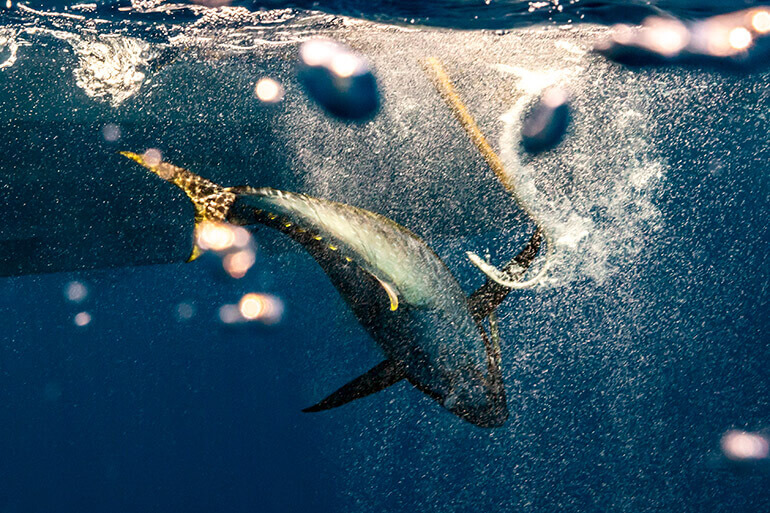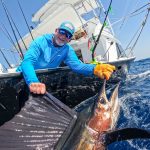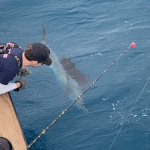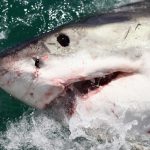Article Courtesy: floridasportsman.com | Originally Published: 11/25/20 | Click here for original article
Preparing Pelagics for the Box
Large pelagic fish can be the best table fare, or that same fish if handled without proper care, can be unfit to feed your dog. It all comes down to how you take care of your fish before it hits the deck. Tunas, swordfish, unintentional marlin kill: If it’s a long fight, and someone’s going to eat it, I’ll follow these iron-clad steps.
Think of it this way. A bluefin tuna that took two hours to bring to leader is heated up, as stressed as a deer run hard by a pack of hounds.
It helps immensely to let that fish cool off—even before the familiar icing stage. Here’s a little trick I learned from seasons in Nova Scotia, Canada. This is an easy step; it only requires taking some time before you pull the fish though the door. Anyone who has ever released a billfish has done this, by holding the bill and letting water run though the gills. You can see the color come back, the fish start to swim on its own, regaining its strength. In North Atlantic waters, many hook-and-line anglers do the same for bluefin: Place a line though its mouth and gill plate and swim the fish until you can see the fish is recovering. This cooling off period, they’ve determined, is a critical step in producing a sashimi-grade product.
The best bluefin in the world today is harpoon-caught, using an electric charged dart that kills the fish instantly. (Disclosure: This is how I make my living; if you’re curious about it, look up my book Harpoon, on Amazon.) That fish doesn’t even know what hit him. One minute the fish is enjoying the afternoon sun, the next it is on ice. This doesn’t mean a hook-caught fish can’t be the same quality; the hook fisherman just doesn’t have the ability kill their fish like a harpooner.
So, after we swim our fish, we now have a somewhat revived fish to deal with, what next? The key here is timing. Once you see the color return and the fish beginning to regain strength, either ike jime (a sharp steel rod driven into the brain; Google for howto videos) or slit the gills letting the fish bleed out. Now you are ready to pull the fish though the door. Very important note, for those of us fishing subtropical waters: You put a half-dead tuna fish on a leash, pretty good chance any sharks in the area will be licking their chops. Keep the fish close, so you can see the fish all the time, and yank it in ASAP if Jaws shows up. Use common sense here.
Some general tips: Harpoon or gaff wounds go on the down-side of the fish. Determine this before you yank the fish onboard. Once the fish is on deck, down-side is downside. Do not turn that fish over. The sheer weight of a 500-pound fish will bruise the down-side, unavoidably, so do not bruise both sides. Once I have my fish on deck, I immediately bleed the fish by making a cross cut about a foot up from the tail, a deep vertical knife cut slicing though the arteries, and then go back to the gill plates cutting all the way around the gill plate to ensure the fish is totally bled out. To avoid any measurement problems with the law, I’ll leave the head on, and gill and gut the fish though the gill plate; larger ones the head comes off. Flush the body cavity well with the washdown hose and stuff as much ice as you can into the cavity. On my boat I have two fish holds that can fit one monster or two smaller fish per side. I’ll cover the whole fish in ice.
If you own a smaller center console, fill every cooler full of ice and bring a good brine bag. You want top quality fish, don’t leave the dock without a bag. There are heaps of bags on the market, a critical piece of equipment in this game. I use 100-inch Engel bags, which have held up for me since 2012.
Targeting swords in the Gulf of Mexico out of Destin, I don’t care about hanging a fish at the dock for a photograph, I only care about eating the beast. Remove head and guts as soon the fish is boated and clean the cavity with the washdown hose. I’ll pack as much ice into the body cavity as I can, then place my fish in the bag and use all the ice available to cover up the fish before zipping the bag up. The fish is coming out of 80-degree water, and the Florida temperatures will eat ice up way faster than up north.
Bring it Home … Or Send it Back?
If you luck into a truly large fish, such as a 100-pound yellowfin tuna or mature swordfish, think of different ways to use your catch and also how long you can store it. Or, whether release might be the better option.
A large king mackerel, for example, won’t keep well in the freezer but grilled fresh, it’s good eating. You might choose to smoke a bunch and have one meal today.
Other fish that do freeze well such as swordfish, cobia and dolphin can be vacuum sealed and frozen for months. It’s best to plan on keeping a few meals for yourself and sharing the rest. The likelihood of you catching more fresh fish before you use all of your frozen stock is pretty good and how often will you thaw a pack for dinner when you have fresh catch on hand?
A little advance planning will help you avoid unnecessarily wasting quality seafood. —George LaBonte, Boating Editor FS






